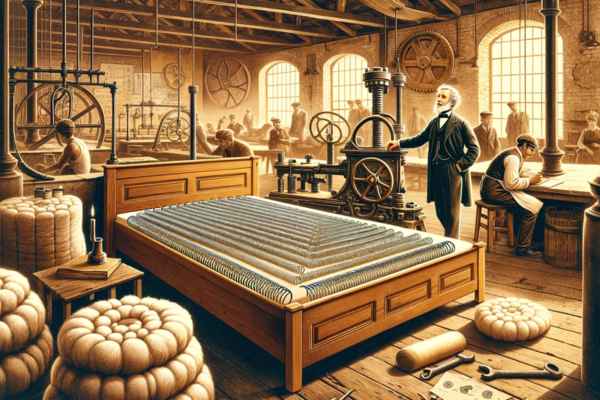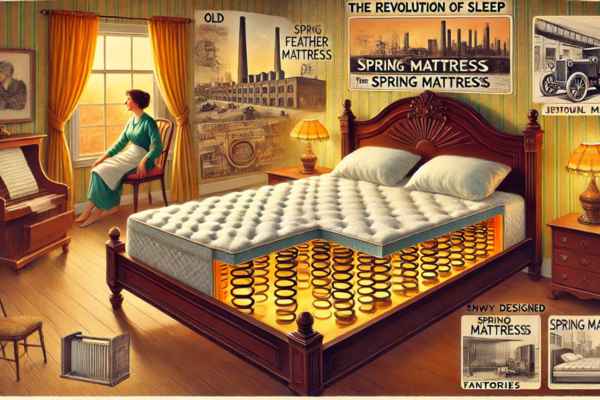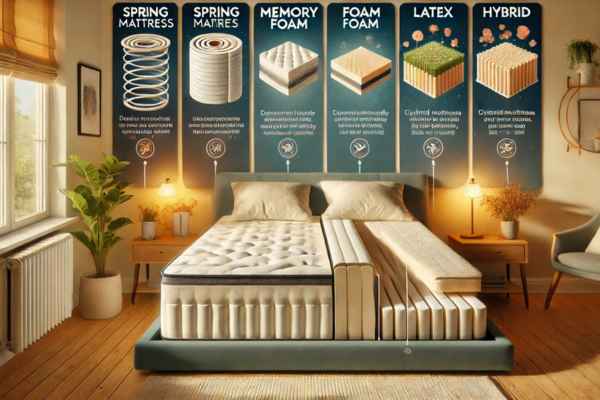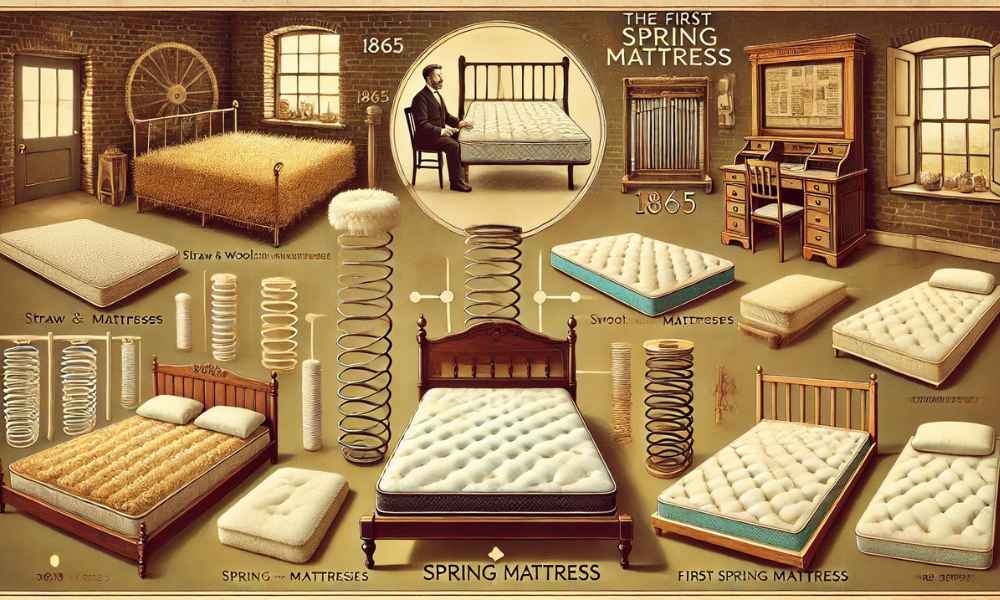The quest for comfort is as old as humanity itself. From crude piles of straw to intricately designed luxury beds, the evolution of sleep surfaces reflects the advancement of civilization. Among these innovations, the spring mattress stands as a pivotal creation, revolutionizing sleep quality and redefining comfort standards. But when was the spring mattress invented, and what led to its development? Before the advent of spring mattresses, people relied on rudimentary materials for bedding—materials that lacked proper support, durability, and hygiene. The invention of the spring mattress marked a turning point, bringing about significant improvements in sleep posture, spinal alignment, and overall restfulness. This article explores the journey from primitive bedding to the game-changing innovation of spring mattresses, delving into their impact on sleep and the continuous evolution of this essential household item.
Early Sleeping Arrangements: What Came Before Spring Mattresses?

Long before modern bedding, early humans slept on natural materials like leaves, straw, and animal hides. These makeshift beds, though rudimentary, provided a buffer between the sleeper and the hard ground. Over time, ancient civilizations such as the Egyptians, Romans, and Greeks introduced more sophisticated bedding solutions.
- Egyptians and Elevated Beds – The Egyptians were among the first to elevate their sleeping surfaces, using wooden frames and woven reeds to create a semblance of comfort.
- Roman and Greek Advancements – Wealthier Romans and Greeks adopted plush cushions filled with feathers, hay, or wool to enhance their rest. These beds, though comfortable, still lacked uniform support.
- Medieval and Renaissance Bedding – By the Middle Ages, beds had become more elaborate, featuring wooden frames and stuffed mattresses. Common fillings included horsehair, wool, and even straw. However, these materials deteriorated quickly, becoming breeding grounds for pests.
Despite these advancements, early bedding lacked the fundamental support necessary for spinal health. Sleepers often suffered from pressure points and misalignment issues, setting the stage for an innovation that would address these shortcomings—the spring mattress.
The Invention of the Spring Mattress: When and How It Happened

The dawn of the industrial age brought forth numerous inventions, including advancements in bedding. The need for better sleep solutions led to the conceptualization of the spring mattress, an innovation that would change the way people rested.
- Early Patent and Development – The first recorded patent for a spring mattress dates back to 1865. Heinrich Westphal, a German inventor, is credited with designing a mattress that incorporated metal springs for enhanced support. Unlike traditional stuffed mattresses, Westphal’s design distributed body weight more evenly, reducing sagging and pressure points.
- Why Was It Revolutionary? – Unlike earlier bedding materials that compacted over time, spring mattresses retained their structure for longer periods. This durability and ability to contour to the sleeper’s body were significant advancements in sleep technology.
- Initial Reception – Despite their benefits, early spring mattresses were expensive and out of reach for the average household. It wasn’t until mass production techniques improved that spring mattresses became widely accessible.
How Spring Mattresses Revolutionized Sleep

The introduction of the spring mattress transformed the way people slept, offering an array of benefits that surpassed traditional bedding options.
- Enhanced Support – By integrating coiled metal springs, these mattresses provided superior spinal alignment, reducing back pain and improving sleep quality.
- Increased Durability – Compared to mattresses filled with feathers or straw, spring mattresses maintained their shape for years without significant degradation.
- Hygienic Advantages – The structure of spring mattresses allowed for better air circulation, reducing moisture retention and preventing the buildup of mold, mildew, and dust mites.
- Widespread Adoption – As manufacturing processes improved, spring mattresses became more affordable. By the early 20th century, they were a staple in households, hotels, and hospitals.
This revolution in sleep comfort made restful, uninterrupted sleep more attainable, paving the way for further advancements in mattress technology.
The Evolution of Spring Mattress Technology

The invention of the spring mattress was just the beginning. Over time, continuous innovations refined its design, resulting in a variety of spring mattress types that cater to different sleep preferences.
- Bonnell Coils (The First Iteration) – The earliest form of coil technology, Bonnell springs, were hourglass-shaped and interconnected, providing a firm sleeping surface. While durable, they transferred motion easily, making them less ideal for couples.
- Pocketed Coils (A Game Changer) – In the early 20th century, pocketed coil technology emerged. Unlike interconnected coils, these individually wrapped springs moved independently, offering targeted support and reducing motion transfer.
- Hybrid Mattresses (Combining the Best of Both Worlds) – In recent years, manufacturers have blended spring technology with memory foam and latex to create hybrid mattresses. These combine the responsiveness of coils with the contouring comfort of foam, providing an optimal sleep experience.
- Smart Mattresses and Customization – Modern advancements have introduced adjustable spring systems, temperature regulation features, and even AI-driven sleep tracking, making mattresses more personalized than ever before.
The evolution of the spring mattress highlights an ongoing commitment to improving sleep quality, ensuring that each generation experiences better rest than the last.
The invention of the spring mattress revolutionized the way people slept, offering a new level of comfort and support that previous bedding materials lacked. The first recorded patent for a spring mattress dates back to 1865, attributed to Heinrich Westphal, a German inventor who sought to improve the sleep experience by integrating metal coils into the mattress structure. This innovation marked a turning point in sleep technology, replacing traditional stuffing materials like straw, wool, and horsehair with a more durable and supportive system. Despite its potential, the early versions of spring mattresses remained a luxury item, only becoming widely accessible as manufacturing techniques advanced in the 20th century.
Comparing Spring Mattresses to Other Types

Spring mattresses were groundbreaking in their time, but today, they compete with various other mattress types, each offering distinct advantages. Memory foam mattresses, for instance, provide excellent pressure relief by contouring to the body, reducing motion transfer and minimizing discomfort for restless sleepers. However, they tend to retain heat, making them less breathable than spring mattresses. Latex mattresses, on the other hand, offer natural resilience and are favored for their eco-friendliness, but they can be significantly more expensive. Hybrid mattresses, which combine coils with memory foam or latex, aim to deliver the best of both worlds—providing the bounce and airflow of springs while enhancing comfort with contouring layers.
Spring mattresses remain a top choice for sleepers who prefer firm, responsive support and better airflow, preventing overheating during sleep. Unlike memory foam, which can feel overly soft or sink too much, spring mattresses maintain their shape well, providing consistent support over time. While newer mattress technologies have emerged, many sleepers still favor traditional spring mattresses due to their affordability, durability, and ability to offer a balanced sleep surface.
The Impact of Spring Mattresses on Health and Sleep Quality

One of the primary reasons for the continued popularity of spring mattresses is their impact on spinal health and sleep quality. The structured support of a spring system helps to keep the spine aligned, reducing the risk of back pain and joint discomfort. Orthopedic experts often recommend firmer spring mattresses for those suffering from lower back pain, as they prevent excessive sinking and promote proper posture during sleep. Additionally, the improved airflow in spring mattresses helps regulate body temperature, reducing night sweats and discomfort for hot sleepers. This breathability is crucial for preventing moisture buildup, which can lead to mold, dust mites, and allergens. While some sleepers may find spring mattresses too firm, many models now incorporate pillow tops or foam layers to add an extra layer of comfort without compromising support.
Choosing the Best Spring Mattress for Your Needs
Selecting the right spring mattress depends on several factors, including body weight, sleeping position, and personal preference. There are different types of coil systems used in spring mattresses:
- Bonnell Coils – The traditional hourglass-shaped coils, known for their durability but higher motion transfer.
- Pocketed Coils – Individually wrapped coils that move independently, reducing motion disturbance and contouring better to the body.
- Offset Coils – Designed with a hinging effect that improves responsiveness to body movement, providing a balance between firmness and comfort.
- Continuous Coils – Made from a single wire running throughout the mattress, offering uniform support but less motion isolation.
For side sleepers, a medium-firm spring mattress with a pillow top can provide adequate cushioning for shoulders and hips. Back sleepers generally benefit from a firmer coil structure that maintains spinal alignment, while stomach sleepers should look for a firm mattress to prevent sinking and lower back strain.
Durability is another key factor when choosing a spring mattress. While high-quality spring mattresses can last 7 to 10 years, lower-end models may lose their support over time. Checking for coil gauge (thickness of the wire) and coil count can help determine the mattress’s longevity—thicker coils and a higher coil count typically indicate better durability and support.
Sustainability and the Future of Spring Mattresses
As the mattress industry evolves, sustainability has become an increasingly important factor in production. Traditional spring mattresses, while durable, have historically contained synthetic materials that contribute to landfill waste. However, modern advancements are addressing these concerns by incorporating recyclable steel coils, organic cotton covers, and plant-based foams into mattress designs.
Many manufacturers are now focusing on eco-friendly alternatives, such as biodegradable materials and mattresses made without harmful chemicals. Additionally, some brands offer mattress recycling programs, allowing customers to return old mattresses for responsible disposal or refurbishment. Hybrid mattresses with sustainable latex or gel-infused foam are also gaining popularity, providing an environmentally conscious option without compromising comfort. The future of spring mattresses lies in continued innovation and customization. With the rise of smart mattress technology, consumers can expect features such as adjustable firmness, temperature regulation, and sleep tracking to enhance their sleeping experience. As sustainability efforts grow, future spring mattresses will likely become more eco-friendly, durable, and tailored to individual sleep needs.
Conclusion
The invention of the spring mattress in 1865 marked a revolutionary moment in sleep history, transforming how people rest by introducing superior support and durability. Over the years, spring mattresses have evolved, competing with foam, latex, and hybrid options while maintaining their status as a reliable and affordable choice. From their impact on spinal health and sleep quality to their role in sustainable sleep solutions, spring mattresses continue to be a staple in bedrooms worldwide. As technology advances and consumer preferences shift, the future of the spring mattress will likely bring even greater innovations, ensuring that people continue to enjoy a comfortable, restful night’s sleep for generations to come.
